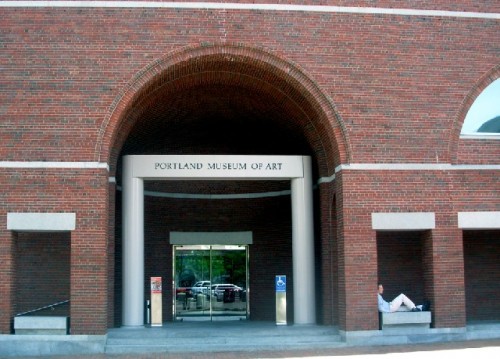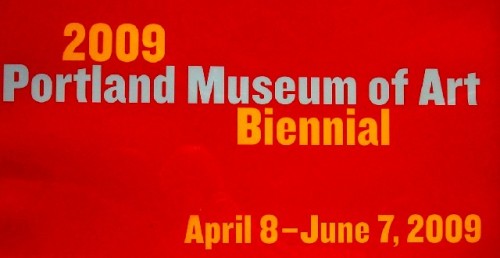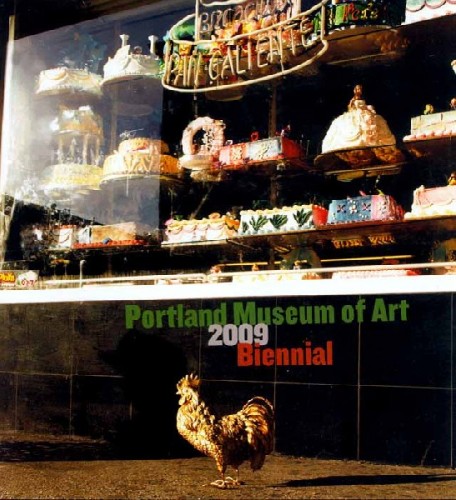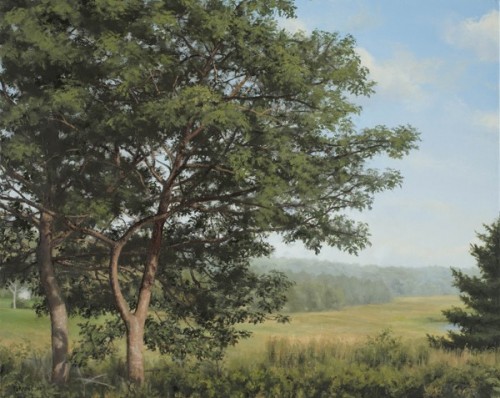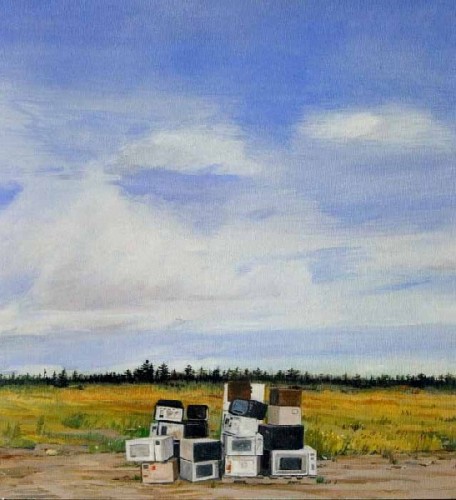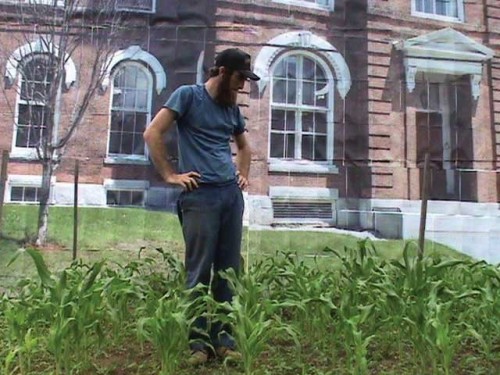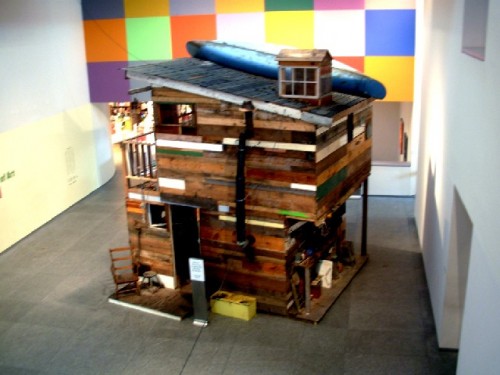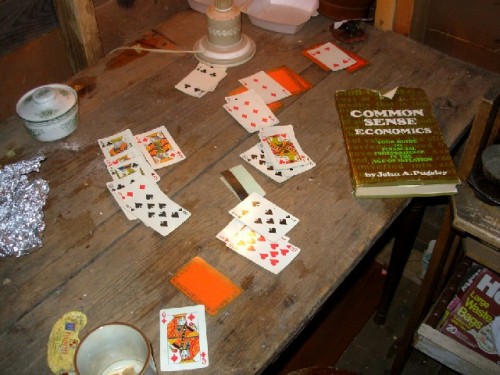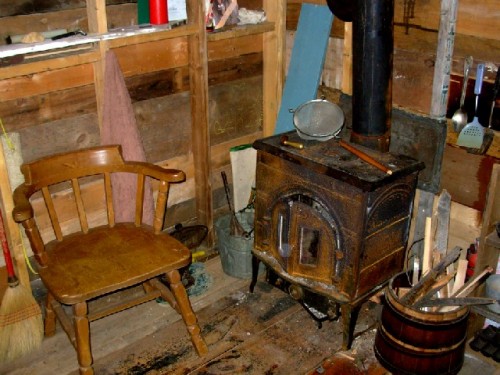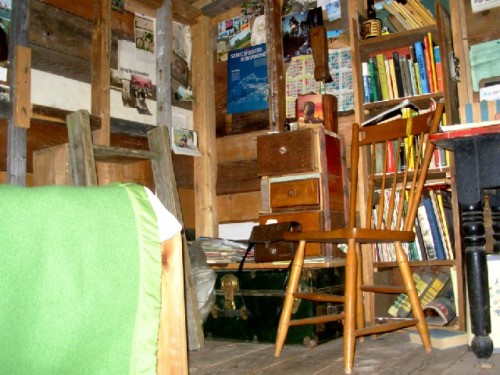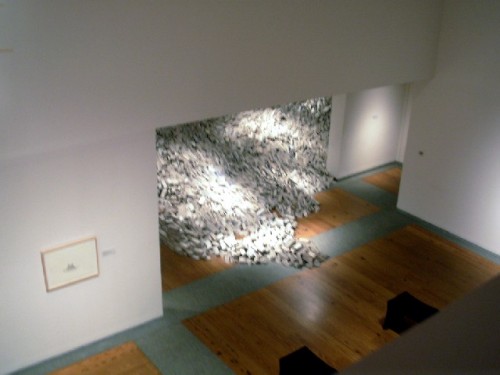Portland Museum of Art 2009 Biennial
The Maine Event
By: Charles Giuliano - Jun 09, 2009
2009 Biennial
Portland Museum of Art
Portland, Maine
Curated by: Elizabeth Burke, Dan Graham and Denise Markonish
Artists: Eric Aho, Mary Aro, Dozier Bell, Melissa Calderon, Tillman Crane, Sean Foley, A. Jacob Galle, Ilana Halperin, Ethan Hayes-Chute, Tanja Alexia Hollander, Wade Kavanaugh, Steven Perkins, Andy Rosen, Julianna Swaney, Susan Hayre Thelwell, Susan Prince Thompson, Sam van Aken.
April 8 through June 7, 2009
Catalogue: ISNN 139-0408, ISBN: 978-0-916857-51-6
Arguably, on any given day, a Biennale or Biennial may be hosting its vernissage somewhere on the face of the earth. Recently, the movers and shakers of the international art world descended on Venice for a week of festivities related to the launch of the oldest and most prestigious of all such events The Venice Biennale.
The global Biennial phenomenon has sorted itself into macro- Venice, Sao Paulo, Documenta- and micro biennials. These smaller events hosted by cities or a single museum are also of great interest as there is often a niche focus on more local and indigenous art. In the mainstream Biennial/ Festival circuit there can be the sense of encountering the usual suspects. This is further emphasized by the fact that the curators that organize the most high profile events and the well traveled critics who cover them often rub elbows and share insights. An artist who makes an impact at one Biennale tends to get invited to other exhibitions. Also, given the nationalistic mandates of the pavilions of Venice, for example, an effort is made for curators to present the most established artists. There is a lot of emphasis on scoring triumphs that enhance careers. It is as close as the art world gets to the equivalent award ceremonies in theatre, film, and music.
As in politics, a case may be argued that all, or the best art, is local. There are the rich and exotic flavors of indigenous circumstances and resultant creations. In that sense every location has the potential to inspire unique works of art. This cultural ethnicity is somewhat undermined by the fact that artists also travel, read art magazines, and attend art schools and colleges. It is as likely that an Inuit artist in the Arctic is using Photoshop to create digital images as carving whale bone. An artist in an African village may be creating traditional crafts or working on conceptual installations.
So trekking to off the horizon Biennials may have oddly mixed results. There is the possibility of unique discoveries and insights as well as the sameold samo. Much of this depends on the vision and ability of the curators to find diamonds in the rough. To what extent can they leave behind their mainstream prejudices and attempt to see what is special about that location and culture. Particularly, when the issues and ideas are not fully developed or ready for prime time. The familiar arguments for the quality and finish of the work often results in a predictable and boring exhibition. Do we really need to make those voyages of discovery just to encounter work that we might find in a New York gallery or museum?
The visit to the Portland Museum of Art 2009 Biennial produced all of the above. It conflated work that would be readily familiar in the context of the mainstream as well as discoveries that were uniquely and delightfully quirky and very, well, Maine. But even that notion is askew. Portland, as we discovered, is a hip and sophisticated city with a truly superb small museum displaying a focused collection of modern masterpieces. Just steps down the street are the Maine College of Art and its Institute of Contemporary Art as well as several satellite galleries. There is a lively mix of commercial galleries and artist run spaces. When we visited the college was presenting its MFA Thesis exhibition which looked, well, like any art school's MFA Thesis show. The students are drawing on the same gene pool of professors and are tapped into issues and agendas that are found in American art education programs.
When we spent the day in Portland there were quite a number of galleries and alternative spaces setting up for First Friday openings. It seemed like a lively environment to pass formative years as an art student or young professor.
Overall, the Portland Biennial was small, just seventeen artists, with works that ranged from intimate to sprawling. The project, for the most part, was quite delightful with some wonderful discoveries. While compact, confined to several galleries in a mid sized, rural museum the exhibition also proved to be manageable. It encouraged us to take the time to encounter and absorb the work of each individual artist. This left us with strong, focused and lasting impressions. It is likely that the jurors; Elizabeth Burke, a co founder of Clementine Gallery in New York City, the video, installation and performance artist, Dan Graham, and Denise Marconish, a curator at Mass MoCA, will use their influence to see that at least some of these artists are seen in other projects.
A catalogue statement by Marconish sketches out the challenge for the team of curators. "My fellow jurors and I started with 970 applicants, which we whittled down over two days to 17 participants and 29 artworks. 13 of these artists live in Maine, only 7 have participated in past Portland Museum of Art Biennials; they range in age from 27 to 79 and include a nearly equal mix of male and femaleÂ…"
It is not entirely clear just what criteria were used for the 3,800 works submitted to the jury. In his introductory remarks Mark Bessire, the director of the museum, states that the Biennial was established in 1998 and that the "Biennial champions the excellence of contemporary artists who have worked or exhibited their art in the state over the previous two yearsÂ…"
Given that Maine is a "Vacation land" there is a broad net of who might be regarded as a Maine Artist. Over the years many of America's leading artists from Winslow Homer, Marsden Hartley and Edward Hopper to the Wyeths and Robert Indiana have lived and worked in Maine. Or have spent time at the Skowhegan School of Art and more recently the Maine College of Art. Many of these renowned artists are well represented in the superb permanent collection of the Portland Museum of Art.
Given the vast eclectic range of work submitted the jurors were encouraged to create a cohesive, hip, and sophisticated exhibition which is more cosmopolitan than rural. It is entirely possible that they selected against a sample of work that might more aptly represent the norm of the kind of work created by the majority of Maine's artists. So we approach this as reviewing what three curators agreed upon rather than drawing broader assumptions about Maine's artists.
The curators have made effective use of the available space, its unique sight lines and vantage points. Even before actually entering the galleries we encounter one of the most compelling works in the exhibition an ersatz Hermit's Cabin created by Ethan Hayes-Chute. There is also a balcony above the galleries which allows us to look down into the space and observe the manner in which a medium scaled, abstract, geometric painting by Sean Foley extends out in design vectors that veer off on the surrounding walls culminating in another, smaller painting. We also gaze down on the installation of brick like slabs, by Wade Kavanaugh, that form a wall and spill out filling its alloted gallery leaching out into the adjoining space. These large scale works dominate the exhibition and seem to anchor in their midst areas where we are drawn in to observe small and intimate works. Much thought and professional acumen has been devoted to navigating the visitor through the exhibition which, despite its diversity, feels remarkably cohesive.
Our first and most engaging encounter was with the funky shack "Hermitage" by Hayes-Chute. Not that the concept itself is original. It evoked seeing Edward Kienholz's recreation of "Barney's Beanery" at Boston's Institute of Contemporary Art under director Sue Thurman, in the late 1960s, when the ICA was located on Newbury Street. One draws comparisons to Gordon Matta Clark and his process of slicing into abandoned houses to create enormous sculptures. Or British sculptor, Rachel Whiteread, casting small houses, rooms and furniture as sculptures. Just a couple of days after viewing the shack by Hayes-Chute we explored the 200 year old Chinese house reassembled in the Peabody Essex Museum in Salem, Mass.
So it was not that the concept of Hayes-Chute was unique. We responded to the compelling manner in which, with exquisite attention to detail, it serves as a vivid signifier for that quirky essence of Maine in all its Yankee eccentricity and backwoods independence. The content of the house, thrown together from a junk yard of found and recycled materials, is so richly resonant that we feel we know its hermetic occupant. There is no question that there are indeed shacks in the woods that are exactly like this in all of its detail, from a hobgobble of odds and ends of furniture, to cards playing some game of solitaire, to stacks of Old Farmer's Almanacs and an assortment of self help books. The two story structure, which we are allowed to enter and explore, has everything one needs to rough out a long, tough winter and its attendant cabin fever. From the vantage of a balcony gazing down into the atrium there is even the nice touch of a canoe on the roof. The work by Hayes-Chute may not travel well but in this context it conveyed the essence of Maine as art.
Just as compellingly eccentric, but on an intimate scale, we were intrigued by the figurative drawings of Julianna Swaney, a 2005 graduate of the Maine College of Art. She is interested in some of the P. T. Barnum like phenomena of the 19th century including a hirsute Wolf Woman looking oddly demure and feminine in a Victorian style, off the shoulder, puff sleeved, full skirted dress. She gazes outward with piercing eyes. Another drawing of a man resembling Abe Lincoln has a beard of swarming bees. The third drawing is a rear view of a standing man in a frock coat and silk hat holding a cage from which has been released a flock of small birds. The drawings of Swaney evoke post modern deconstructions of 19th century curiosities.
Susan Prince-Thompson, of Wilton, New Hampshire shows with Portland's June Fitzpatrick Gallery. She creates Islamic evoking, filigreed cutouts from brown paper bags. These intricate designs have been attached to strings forming lines of an installation. One is absorbed by the exquisite detail but are not assured that they mesh as a cohesive work. It is unclear what the works are about beyond a fascination with the skill and detail of their execution.
If you are eager to make that Maine connection the works by Mary Aro, Steven Perkins, and Eric Aho provide some comfort and reassurance. Perkins, who shows with Susan Maasch Fine Art in Portland is as close as this exhibition allows us to the notion of traditional Maine landscapes. He is represented by a small, nicely detailed, and finished view of "Two Oak Trees." It makes one think of the Hudson River master Asher B. Durand. Aro, who was born in 1929, is the senior in this selection of mostly younger artists. While she is a representational artist of conventional ability what places her in this cutting edge context is quirky, and very Maine, subject matter. She lovingly renders that trailer trash landscape that we mostly pass by with just a touch of urban scorn. Instead of the sublime landscape she renders a pile of abandoned microwaves set in front of a distant row of pine trees. Or a generic, green, mobile home with a pickup and a car parked out front. She opts to render sites that are the opposite of picturesque. Aho offers a slice and glimpse of Nordic life with an austere, minimalist, but compelling painting of a square "Ice Cut." It is an enigmatic image as we have no clue to its intentionality beyond formal qualities of design, color and surface execution.
Because of the modest scale of the exhibition, and the time we allotted to its viewing, we sat and viewed in their entirety, well almost, the wildly, absurdly, hilariously, gonzo videos of a true genius and nutball, A. Jacob Galle. In his statement he describes making art when he can while supporting himself, such as it is, working as a farmer and woodsman. "Being born in Maine, and growing up on a sheep farm here, I quickly learned about the land and hard work."
In the two amazingly original, fresh, clever videos the artist invents absurd tasks to perform. He has conflated his work/ work, job/job survival ethos with an artificial extension of that instinct and discipline in outrageous parody. In an ultimately dada gesture he puts enormous sweat equity into the absurd accomplishment of absolutely nonsensical tasks. Brilliantly, with frenetic speed and accelerated, herky jerky action he plotted a garden to grow corn and then created an illusion of a house we glimpsed early on by tacking up sections of details to create a composite whole. Does this make sense? Probably not, which is, well, kindah the point, I guess. There are lots of twists and turns before a surprise ending which we won't reveal. The shorter (6:22 minute) first video "Untitled (Cubicle)" 2005 set us up for and took some of the surprise out of the second, longer (21:07 minute) video "Untitled (Spring Fever/ Pilgrimage)" 2008. It started with the artist doing a load of laundry which was then stuffed into a back pack. This was followed by a mountain trek where, you guessed it, with Herculean effort he strung up a line between jagged peaks to hang out the wash to dry. Duh.
Much of the inventive gag aspect of Galle's videos evokes the masters of silent cinema like Charlie Chaplin and Buster Keaton. Not bad company. Let's hope that Galle spends less time farming and scratching out a living and more effort directed toward creating these wonderful and witty videos. This is work that deserves to be seen at one of those big time Biennials. It would be nice if Denise can work him into a show at Mass MoCA. Hello, is anybody out there? We are talking about a potentially major art star.
For a time the painter Sean Foley taught at the Maine College of Art and has relocated to Ohio. He will be familiar to Boston readers as he showed with the former gallery Allston Skirt which focused on emerging artists as well as the DeCordova Museum. In 2004 he had a solo show with Mary Ryan Gallery in New York. The abstract paintings belong to a Post Op/ Geometric sensibility. The work reminds me of Will Mentor's paintings while the wall crawling evokes Sarah Sze. The work was bright, flashy and catchy.
There is a tipping point at which I start to loose interest in an exhibition. The initial phase involves being excited and involved with some of the work. But coming to grips with that response seems to tap into reserves of energy and the familiar ADD syndrome kicks in. Particularly in an eclectic group show with no unifying theme. As focus tails off there is less patience for the ordinary or overly familiar.
The conceptual trope of Melissa A. Calderon to relocate and photograph a life size, metal rooster just seemed tedious and trite Spare me. In a second, unrelated work, Calderon has created a cascade of tear soaked tissues falling in an arc from a container attached to the wall. I just wasn't interested in learning what that furry thing gripped by hands in Susan Hayre Thelwell's "Marking," an archival pigment print, was all about. Similarly I was bored by the precious, small, tonal studies by Dozier Bell, yawn, or the artsy, pretentious chromogenic prints by Tanja Alexia Hollander. So what that Wade Kavanaugh stuffed a space with bricks of sheetrock. Who cares? And that sphere of car speakers by Sam van Aken seemed so over. Even in Maine, good grief. That idea was edgy maybe a generation ago.
Oops, sorry about that. There I go being cranky. Dragging along my big time attitude to small market Portland. But maybe it's not all my fault. Perhaps some of those works that failed to evoke much interest reflect the gravitas and blinders of the curators. As Dan Graham stated "We, the jury, looked for work that was not the cliché repeats of John Marin, Marsden Hartley, or seascape photos with the craggy rocks and surf associated with Maine's art scene." Wrong. Maybe a craggy rock here or there would have been interesting and a heck of a lot more about Maine. This exhibition, after all, was assembled in Portland, not Venice, Sao Paulo, or Kassel.
Which, of course, is the point of any ambitious Biennial. It gives us an occasion to debate and dissent. That said, overall, this was a real nice show. Wish we had time to hang out during that First Friday. Perhaps another time..

